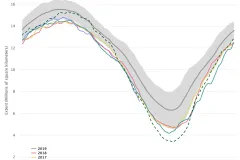Arctic Sea Ice: A New Low?

At a recent staff meeting a Smithsonian colleague mentioned that one of his pastimes this summer has been keeping tabs on the Arctic sea ice. The question that's on many Arctic-watchers' minds is whether or not the 2011 sea ice coverage will reach a new record low.
The National Snow and Ice Data Center collects and provides much of the information on Arctic sea ice. One of the main numbers they report is the "sea ice extent." It's a figure that's been measured since 1979. This week NSIDC reported that, "If ice stopped declining in extent today it would be the second-lowest minimum extent in the satellite record." Although summer is coming to a close and temperatures are dropping in the Arctic, the ice may continue to melt.
Arctic sea ice does vary from year to year, and researchers are studying the overall decline. For many, the status of the Arctic sea ice points to bigger questions about sea-level rise and climate change. Fortunately a number of scientific agencies and organizations are investigating the impacts that may arise from a thinning Arctic. And, lucky for us, they're using video, photos, and blogs to share some of their observations.
We recently posted the hugely popular "Under Arctic Ice" photo essay about a NOAA expedition and a video of NOAA's Arctic Exploration activities, but here are a few other interesting finds we've come across this summer:
- A timelapse video from a NOAA North Pole webcam (posted above). The camera was stationed on an ice floe and typically records snow and ice coverage from April through October. Not this year. It tipped over on July 23, 2011. The culprit: melting ice.
- With all the coverage of the space shuttle program coming to a close, you may have missed NASA's voyage to the North Pole. They're calling the mission: ICESCAPE. The goal is to examine the changes in the chemistry and ecology of the Arctic. The 2011 expedition wrapped up in July, but you can read the blog posts and see the photos online. They use a tool to gather "profiles of optical properties below sea ice and melt ponds." This should help them better understand how much light is making it through the ice for photosynthesis to happen.
- The Sea Ice for Walrus Outlook website helps subsistence hunters in Alaska and is a reminder of some of the real-life consequences that Arctic ice melt can have.
Back to the question at hand: will this year set a record low for Arctic sea ice extent? Here's the answer that our friends at the National Snow and Ice Data Center posted on September 6:
"Whether Arctic sea ice breaks a new record hinges on three factors: First, how much heat is left in the ocean to eat away at the ice edge and bottom? Second, will wind patterns blow the ice together and reduce ice extent or will they disperse the ice and expand ice extent? Finally, just how thin is the remaining ice cover? Thin ice quickly melts away when it is surrounded by warm water."
We'll be waiting to see what happens.

